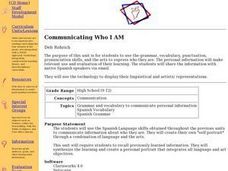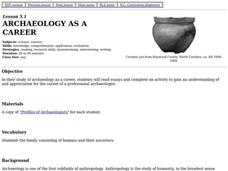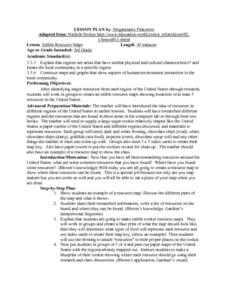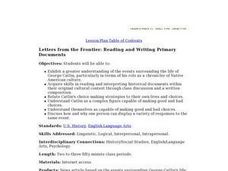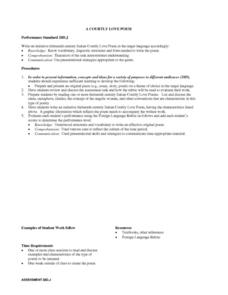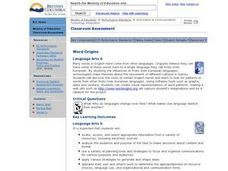Curated OER
"Here Comes the Train"
Students read and explore the story, The Little Engine that Could, by Watter Piper.
Curated OER
Communicating Who I Am
Students practice their Spanish grammar, vocabulary, punctuation and pronunciation skills by creating a personal portrait and personal narrative, and sharing it with native Spanish speakers via email.
Curated OER
Evolutions of Pottery
Students study the history and importance of clay and pottery. They observe a video dealing the kiln. Students explore ideas for improving construction of pottery. They demonstrate a variety of construction methods and identify the...
Curated OER
Exploring Literary Genre Through Latin American Literature
Young scholars explore poetry and its meaning. After reading poems, students explore the literary elements such as the setting, character, problem, events and resolution. They compare and contrast descriptions given in poems. Young...
Curated OER
Dubois and Washington Venn Diagram
Young scholars compare and contrast the visions of W.E.B. Dubois and Booker T. Washington. In this African American history instructional activity, students read biographies about both men and create a Venn diagram about the men.
Curated OER
Archaeology as a Career
Fourth graders read about archaeology as a career. They develop a list of questions they would like to ask an archaeologist and then actually interview an archaeologist on the future of archaeology as a career.
Curated OER
The Medium And The Message
Students compare and contrast Buddhist sculpture in varying materials through in-class discussions and small cooperative learning groups. This lesson includes possible lesson extensions.
Curated OER
Cocina Mexicana
Young scholars research authentic Mexican food recipes on the Internet and translate them into English noting any new vocabulary. They present their recipes and vocabulary to the class.
Curated OER
Edible Resource Maps
Third graders work in groups to create an edible resource map showing locations of at least five resources in the United States. Students research on the internet different regions and the resources that are found in those areas. They...
Curated OER
Letters from the Frontier: Reading and Writing Primary Documents
Students examine historical documents about George Caitlin to derive meaning about his life and contributions. The lesson is multicultural and helps students to appreciate art and history.
Curated OER
Social Studies: Ramadan Observance
Students discuss Ramadan and the practice of fasting. Working in groups, they visit Websites and complete worksheets about the Muslim holiday. Students write letters role-playing as someone unfamiliar with a celebration and then write...
Curated OER
A Courtly Love Poem
Young scholars engage in a writing assignment to produce a thirteenth century Italian Courtly Poem. They imitate the literary patterns of writing to produce a unique poem using a model for example. Students review the basic terminology...
Curated OER
Who's a Hoosier?
Fourth graders examine the history of Hoosiers and define what a Hoosier is. In small groups they discuss any stories they know about the word Hoosier, then brainstorm and write a story about the word Hoosier. Each group shares their...
Curated OER
Language Arts- Word Origins
Sixth graders locate, access, and select appropriate information from a variety of resources, including electronic sources. They analyze the audience and purpose of the task to make decisions about content and format.
Countries and Their Cultures
Countries and Their Cultures: Nuristanis
The area known as Nuristan is located at the southern end of the Hindu Kush mountain range in Afghanistan. There are limited amounts of arable land in the Hindu Kush, but there are abundant amounts of pastureland well suited for...
Countries and Their Cultures
Countries and Their Cultures: Kipsigis
Kipsigis are the southernmost and most populous of the Kalenjin peoples of Kenya. The term "Kalenjin" (lit. "I say to you") was coined in radio broadcasts and at political rallies during the late colonial period, at a time when political...
Countries and Their Cultures
Countries and Their Cultures: Tropical Forest Foragers
The term "tropical-forest foragers," or "pygmies," refers to ethno-linguistically diverse peoples distributed across the forested regions of Central Africa who are particularly short in stature and who traditionally have lived by...
Countries and Their Cultures
Countries and Their Cultures: Turks
Ethnically, the Turks are a cultural group united by a common language, but the term "Turk" has no clearly defined racial significance; it can be properly applied to those communities historically and linguistically connected to the...
Countries and Their Cultures
Countries and Their Cultures: Pedi
"Pedi," in its broadest sense, has been a cultural/linguistic term. It was previously used to describe the entire set of people speaking various dialects of the Sotho language who live in the northern Transvaal of South Africa. More...
American Institutes for Research
Center on Response to Intervention: A Cultural, Linguistic, Ecological Approach
This 2008 brief discusses how RTI can be adapted for English Language Learners (ELL). It provides an initial framework in the use of RTI that considers students' life experiences, including their language proficiencies in their first and...
Countries and Their Cultures
Countries and Their Cultures: Aimaq
In western Afghanistan and far eastern Iran, "Aimaq" means "tribal people," which distinguishes the Aimaq from the nontribal population in the area, the Persians (Fariswan) and Tajiks. Most of the population of live in Afghanistan; those...
Countries and Their Cultures
Countries and Their Cultures: Mijikenda
The group known as the Mijikenda is made up of nine closely related but distinct peoples - the Kauma, Chonyi, Jibana, Giriama, Kamabe, Ribe, Rabai, Duruma, and Digo - who live along the coast of Kenya and share a common linguistic and...
Countries and Their Cultures
Countries and Their Cultures: Yoruk
The Yoruk are an ethnic-tribal grouping found widely throughout Turkey but primarily along the Aegean and Mediterranean coasts. The Yoruk are not linguistically distinct from most of the rural populations among whom they live. They speak...
Countries and Their Cultures
Countries and Their Cultures: San Speaking Peoples
San-speaking peoples do not constitute an ethnic group in the usual sense. The most widely known are those who call themselves "Zhu I oasi" (!Kung or Juwasi in most ethnographies), although the other peoples mentioned above have also...



